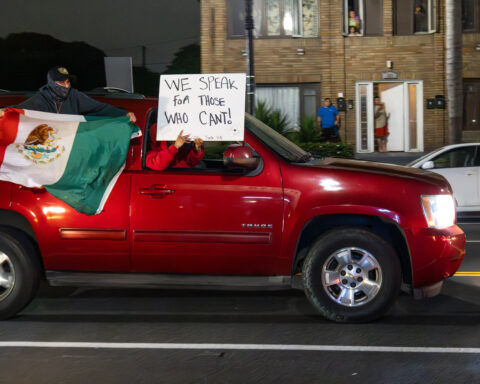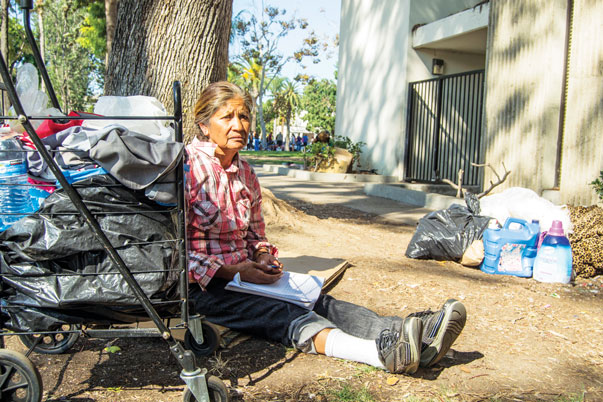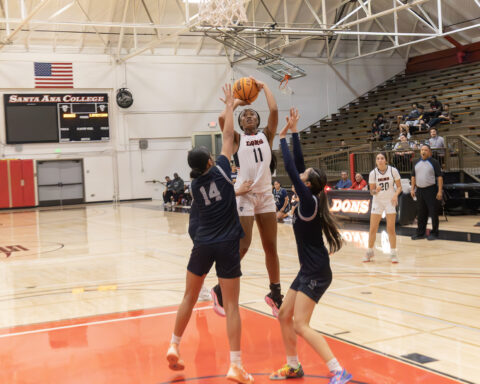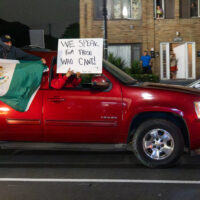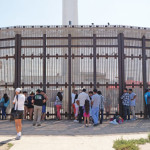By Jose Servin
On an 85-degree Sunday afternoon, a Spanish-speaking Irish priest presses his body against the U.S.-Mexico border fence with a wireless microphone in his hand. His makeshift altar, composed of a wine cup, a sacramental bread plate and pictures of people praying in the desert, lies on a dusty carpet around his feet.
“We leave our denominations at the door,” said the Rev. Dermot Rodgers, who is also an immigrant.
Quietly listening to Rodgers’ sermon stands Enrique Morones, the founder of Border Angels. He leans against a chain-link fence marking the farthest extremity of the cement circle on which he stands.
Both men are flanked by families, huddled against the fence, separated by a steel wall from their loved ones on the other side.
This is Friendship Park.
Two sisters took the grueling trek from San Francisco to see their parents, who traveled from Guerrero to Tijuana. Out of fear of getting too close to the border, the sisters missed their freeway exit and arrived after the park closed. The parents paid for a hotel and waited for a week in Tijuana, not surrendering their hope of being able to see their daughters after 12 years. Separated by rusted steel, they were held back by the fence, unable to touch.
The families seen at this park are the casualties of a nation divided over immigration since President Lyndon B. Johnson signed the Immigration and Nationality Act 50 years ago.
Near the Pacific Ocean, where welded iron bars sink into sand and divide waves, is Friendship Park, a place where families cross countries to meet and hear Father Dermot deliver Sunday mass to soothe their aching hearts.
The park is between two fences. One is made of rusted steel, similar in color to the land it is driven into, and serves as the border between the U.S and Mexico. The other, a silver behemoth with bars like teeth and floodlights like eyes, is another boundary. It marks the beginning of a no-man’s land.
When Johnson was in office, a single, barbed-wire fence covered the area.
On weekends, there is a door in the silver fence that opens between 10 a.m. and 2 p.m. This is the entrance to the park.
It is the only place along the entire 2,000-mile border where those who do not possess the necessary documents to leave and return to the United States are able to see their families.
But getting there is arduous.
The park sits on federal land monitored by U.S. Customs and Border Patrol agents and can be accessed through Border Field State Park, which also houses an estuary where the murky Tijuana River drains into the Pacific Ocean.
Sometimes the gate to the trails in the park is open and you can drive up to the hill. But usually the path is flooded with heavy sewage that takes months to evaporate, Rodgers said.
The Catholic priest visits most Sundays, working with pastors from other churches and activist organizations
to host a brief mass for visitors on both sides.
Here, men of faith set aside their theological disagreements to promote the unification of families.
Like every visitor, Rodgers must walk the 1.4-mile journey from a dirt parking lot at the entrance of Border Park to the fence.
He is fearful that one day it might close. Rain, heat and flooding of the trail prevent visitors from coming, Rodgers said.
Rodgers and Morones work closely with UCBP and the immigrant community to bring awareness to the area.
Both are on the board for Border Angels. The group is known for leaving water in the desert area around the border crossing where many who attempt to pass die of dehydration or from the consequences of extreme heat.
They have organized events such as the opening of maintenance doors on National Kids Day every year so that families can hug and meet each other.
Few are willing to do what the sisters have done. A checkpoint that opens at random times near San Clemente is enough of a threat to people’s presence in the U.S that it discourages many from ever going past it.
Rodgers’ counterpart on the Mexican side of the border collaborates with him, along with a choir of three guitarists, to give mass.
The Mexican side is not a wasteland. Instead, the border marks the end of Plaza de Toros, a bustling market place home to brass-laden Mexican corrido bands whose music blares over loud speakers. Scores of tourists walk around, mingling with Mexican families hoping to catch a glimpse of their loved ones across the wall.
Along with other immigrant-rights activist groups, Morones hopes for a reform in immigration policy.
He notes that with the 2016 elections approaching and politicians like Donald Trump receiving support for an anti-immigrant political platform, the 11 million who are undocumented in the U.S need a leader.
Programs like Deferred Action for Childhood Arrivals, which grants work permits for students who meet certain requirements, have made working and getting an education easier for undocumented students, or Dreamers. Still, no real path to citizenship exists. Crossing over is not an option.
“There’s always the question of why these people don’t come over legally. The truth is they can’t. These people do not qualify for visas,” Morones said.
Waiting To Cross
There is no path to citizenship for immigrants who entered the United States illegally.
11 million immigrants, undocumented, from Mexico were living in the U.S in 2014.
46 percent of immigrants report having Hispanic or Latino origins.
1 million students have been approved for Deferred Action as of 2015
- Inside el Don’s 2025 Immigration Issue - October 14, 2025
- Talk to us! We’re community reporters - October 14, 2025
- Local punk scene provides support during ICE raids - July 17, 2025







